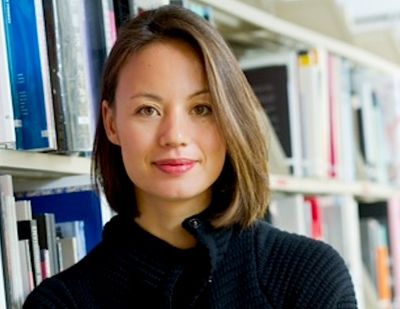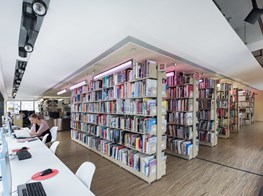Claire Hsu

Claire Hsu is Co-founder and Executive Director of Asia Art Archive (AAA). Instrumental in shaping the Hong Kong contemporary art scene, AAA is an independent non-profit organisation with one of the most comprehensive collections of material on contemporary Asian art in the world.
In addition to housing over 37,000 records, AAA organises a dynamic platform of diverse public, educational, and residential programmes for a wide range of audiences. AAA is the official cultural partner for Art Basel in Hong Kong.
Hsu sits on the committee of M+ and represented AAA as a consultant for the Central Police Station redevelopment project that will turn that space into an arts hub in 2009.
After all, the very nature of the archive is determined not by what gets included, but what gets excluded.
OEYou were 24 years old when you started the Archive in 2000. It was initiated to document and secure the multiple recent histories of contemporary art in the region. Have you achieved what you set out to do?
CHThe very notion of an archive is long-term. It is a project that will go on beyond my lifetime. The collection will continue to grow, and there is always so much more that we can and would like to do. However, we realise the importance of networks, collaboration, and partnerships in this process.
We don't see AAA growing in isolation but as part of a wider network. Additionally, our collection is not about possession—we gladly accept digital copies of material held elsewhere—or controlling the reception of material, but about enabling multiple interpretations through access, collaboration, and connection.
OEAAA's Open Platform at Art Basel in Hong Kong certainly seems to be aimed at fostering these connections.
CHYes, Open Platform will allow selected individuals and institutions to use the Archive's network to host meetings in AAA's booth at Art Basel in Hong Kong. These open meetings will be an opportunity to make new connections, but also hopefully to ignite and catalyse projects.
OEThe Archive now has a collection of over 37,000 records, comprised of hundreds of thousands of physical and digital items. How does the Archive decide what material to include?
CHI think at the beginning, nearly 13 years ago, we naively believed that we would house all orphaned material and bring it together under one roof. AAA was in set up in response to an urgency in the field—a lack of research, scholarship, and critical thinking that was largely due to a general lack of access to materials and information.
We now are clear about the fact that AAA is not a comprehensive collection. After all, the very nature of the archive is determined not by what gets included, but what gets excluded. So I think we are very aware that on the one hand there is an organic nature to AAA—85% of the material is donated from multiple institutional and individual sources—but there are also very clear choices that are made in the organisation of material in terms of areas that we feel are important to focus on and highlight through our research, collection, and programmes.
As an independent platform we feel that we are in a unique position to be able to focus on areas that we know have been important in shaping art discourse in the region and yet for various reasons have been overlooked.
OEHow do you determine what to focus on?
CHThere are a number of factors that determine our focus. As an independent platform we feel that we are in a unique position to be able to focus on areas that we know have been important in shaping art discourse in the region and yet for various reasons have been overlooked. The more visible discourses are being shaped either by the market or national agendas, especially in light of, for example, a lack of independent public institutions or art history departments in universities. We are able to offer a different perspective.
OEIt's an excavation of the cracks?
CHYes, and what that means is that even in a place like China—which everyone sees as having a very well documented contemporary art history—it is important. China's recent art history has been written by a handful of individuals closely related to its development. Still today, these narratives frame the way this history is read. China is obviously a very big country with many artists, which is why we embarked on 'Materials of the Future: Documenting contemporary Chinese art 1980 — 1990', a project which looked to open up the different ways in which the important period of the 1980s can be researched and considered. We spent four years interviewing writers, curators, and artists, and we built a digital archive of 100,000 items of material for research. The Robert H. N. Ho Family Foundation Grant is enabling us to conduct an extension of this Project.
OEHow does the Archive define 'Asian Art'?
CHWe don't see ourselves as exclusively 'Asian.' We are not 'Asian' Art Archive but Asia Art Archive. Asia is a location, a method, and an anchoring point. The boundaries of the map that define Asia for us are constantly shifting in response to external and internal priorities and developments. We are interested in excavating specific local histories but also comparative studies that take us out of what is normally considered to be within the boundaries of Asia.
At the same time, we are physically located in Hong Kong, and the team is predominantly from here, and so we are inevitably shaped by developments in our immediate communities. We, however, feel it important to connect and consider Hong Kong in the context of issues beyond the city's borders and are constantly shifting back and forth to address these perspectives.
The upcoming third issue of our on-line journal, Field Notes is tentatively called 'Mapping Asia.' We will be exploring the texts, ideas, and works that influence our idea of 'Asia' and hope to open up the imaginary within this space.
We spent four years interviewing writers, curators, and artists, and we built a digital archive of 100,000 items of material for research.
OECertainly this topic was reflected in the work produced by Map Office during their residency at AAA?
CHThe Map Office project was a very interesting way to re-categorise the Archive. As part of their residency, the artist/architect duo created an atlas of real and imaginary places found in the Archive, a unique visual cartography in which combinations of text and image dissolve the conventional borders of Asia.
OEHow does the concept of 'unmapping Asia' relate to your research centers?
CHPart of 'unmapping' Asia is that we have moved away from country-representative researchers to projects researchers working on specific areas of focus.
Our project researcher in India, Sabih Ahmad, for example, has initiated an ambitious project that we are working on in India at the moment. We are compiling India's first bibliography of 20th century art writing. We have 7,000 entries so far in 11 regional languages. The bibliography will eventually be made publicly accessible on-line as a research tool. The long-term plan is to develop a series of published and digital anthologies—the culmination of a series of research projects we have developed in India over the years.
OEThe 'archive' as a motif is very prevalent in art at the moment.
CHCertainly, the archive is extremely prevalent as a topic in theory, practice, and the institution today. There is a widespread move to re-consider, question, and open up the concept of the archive.
I am very interested in what the archive can do, and how something that was created as a system to rationalise, can in fact become a space where accepted perceptions can be challenged. While there are many archives that are strictly governed by archival laws—what is included, how it is catalogued, and who is allowed to access it—at AAA we are interested in the multiple subjectivities that make and get embedded within the archive.
There are many innovative archival initiatives around the world. For example, in Latin America, there is the 'Southern Conceptualisms Network'. This network, comprised of researchers, artists, archivists, curators, and writers, is working to preserve archival materials within the places they have been created. This is one of a number of different initiatives.
Part of 'unmapping' Asia is that we have moved away from country-representative researchers to projects researchers working on specific areas of focus.
OEHow do you think this fascination with the concept of the archive relates to the object?
CHI see a growing movement away from the traditional museum model where ultimate value is attached to the art object, and where a museum's value is determined by how many objects it has in its collection as opposed to being its custodian within the greater commons.
There are a number of collecting institutions that are reconsidering the value of the artwork/object in relation to the material and contexts of how we understand and read the object. In the Van Abbe museum, for example, the archive has been brought up from the basement to occupy a key position in the institution and the archivist is part of the curatorial team.
I think there is an interesting shift in how artwork is no longer being presented as something finished. In these ways, the traditional white cube model is increasingly being tested. And arguably, because of the digital age and the freedom and circulation of knowledge, you no longer always see the work to fully appreciate it.
OEIn 2010, in order to make more of its collection available to the public, AAA began a major digitisation initiative and launched its Collection Online. How important is the Internet to your future plans?
CHEssential. We spent four years on the new website.
The reason we launched the website and will continue to allocate resources to developing the digital platform, is essential to our philosophy of accessibility, and ultimately to distilling dominant art historical narratives. The long-term contribution of the Archive will be its contribution to enriching and complicating global art historical narratives.
It allows people to think beyond the art history they have been taught. Once all of this material is out there you cannot ignore it. —[O]













































































































































































